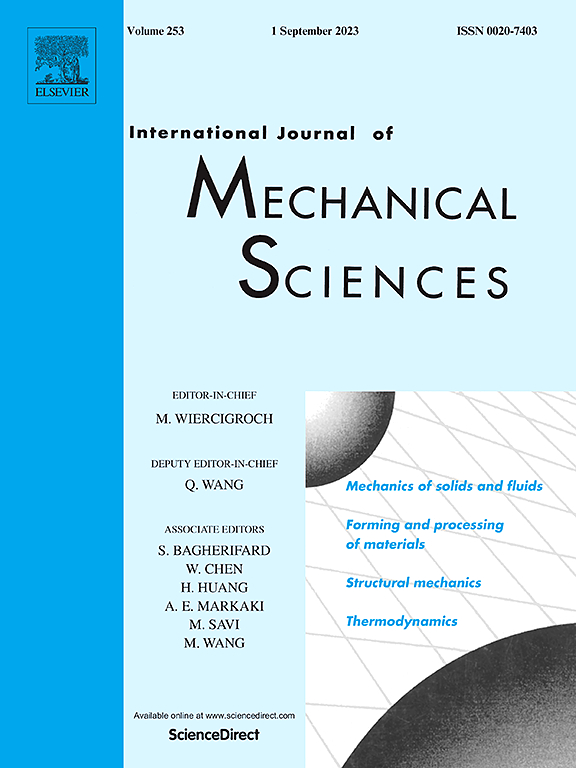Tooth-shape electromagnetic vibration absorber with adjustable positive and negative stiffness
IF 9.4
1区 工程技术
Q1 ENGINEERING, MECHANICAL
International Journal of Mechanical Sciences
Pub Date : 2025-06-08
DOI:10.1016/j.ijmecsci.2025.110480
引用次数: 0
Abstract
To achieve adjustable positive and negative stiffness characteristics and broaden the operational frequency bandwidth, this study proposes a tooth-shape electromagnetic vibration absorber (EVA). The EVA comprises a mechanical spring, an iron oscillator, a coil, and an iron stator. Structurally, it is divided into two subsystems: a negative stiffness component (EVA-1) and a positive stiffness component (EVA-2), and each of them utilizes different mechanical springs. EVA employs an electromagnetic tuning mechanism to adjust the current, which is able to automatically switch stiffness characteristics according to the target frequency band of vibration suppression. An analytical model of electromagnetic force generated by EVA is established based on magnetic flux lines, considering tooth width and pitch. The displacement intervals fall into three categories based on the relative position of the oscillator and stator teeth: (1) partial overlapping, (2) complete overlapping, and (3) complete separation. The analytical results are validated by comparison with finite element simulation and experimental data. EVA has been successfully fabricated, and its performance has been evaluated. Experimental results exhibit that EVA-1 provides the stiffness tuning bandwidth from 7.7 Hz to 9.7 Hz, while EVA-2 provides the tuning bandwidth from 13.7 Hz to 17.3 Hz. The measured stiffness characteristics align well with the results of Maxwell finite element analysis as well as the analytical model. In the vibration suppression experiment, EVA-1 and EVA-2 demonstrate significant effectiveness, reducing the vibration by more than 76% and 89%, respectively. These findings highlight the promising potential of EVA for real-world vibration control applications, particularly in scenarios requiring broadband frequency adaptability.

齿形电磁吸振器,正负刚度可调
为了实现正负刚度特性可调,拓宽工作频带,本研究提出了一种齿形电磁吸振器(EVA)。EVA包括机械弹簧、铁振荡器、线圈和铁定子。在结构上,它分为两个子系统:负刚度组件(EVA-1)和正刚度组件(EVA-2),每个子系统使用不同的机械弹簧。EVA采用电磁调谐机构调节电流,能够根据抑制振动的目标频带自动切换刚度特性。考虑齿宽和节距,建立了基于磁通线的EVA电磁力解析模型。根据振子齿与定子齿的相对位置,位移间隔分为三类:(1)部分重叠,(2)完全重叠,(3)完全分离。通过与有限元仿真和实验数据的对比,验证了分析结果的正确性。成功制备了EVA,并对其性能进行了评价。实验结果表明,EVA-1提供7.7 ~ 9.7 Hz的刚度调谐带宽,EVA-2提供13.7 ~ 17.3 Hz的刚度调谐带宽。实测刚度特性与Maxwell有限元分析结果及解析模型吻合较好。在减振实验中,EVA-1和EVA-2的减振效果显著,分别达到76%和89%以上。这些发现突出了EVA在实际振动控制应用中的巨大潜力,特别是在需要宽带频率适应性的情况下。
本文章由计算机程序翻译,如有差异,请以英文原文为准。
求助全文
约1分钟内获得全文
求助全文
来源期刊

International Journal of Mechanical Sciences
工程技术-工程:机械
CiteScore
12.80
自引率
17.80%
发文量
769
审稿时长
19 days
期刊介绍:
The International Journal of Mechanical Sciences (IJMS) serves as a global platform for the publication and dissemination of original research that contributes to a deeper scientific understanding of the fundamental disciplines within mechanical, civil, and material engineering.
The primary focus of IJMS is to showcase innovative and ground-breaking work that utilizes analytical and computational modeling techniques, such as Finite Element Method (FEM), Boundary Element Method (BEM), and mesh-free methods, among others. These modeling methods are applied to diverse fields including rigid-body mechanics (e.g., dynamics, vibration, stability), structural mechanics, metal forming, advanced materials (e.g., metals, composites, cellular, smart) behavior and applications, impact mechanics, strain localization, and other nonlinear effects (e.g., large deflections, plasticity, fracture).
Additionally, IJMS covers the realms of fluid mechanics (both external and internal flows), tribology, thermodynamics, and materials processing. These subjects collectively form the core of the journal's content.
In summary, IJMS provides a prestigious platform for researchers to present their original contributions, shedding light on analytical and computational modeling methods in various areas of mechanical engineering, as well as exploring the behavior and application of advanced materials, fluid mechanics, thermodynamics, and materials processing.
 求助内容:
求助内容: 应助结果提醒方式:
应助结果提醒方式:


